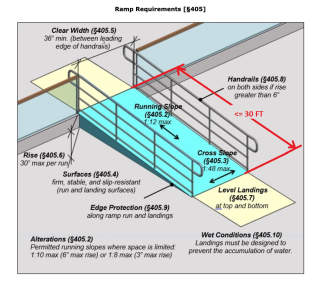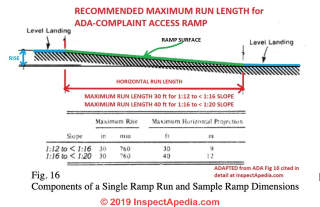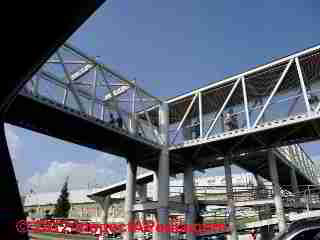 Building Access Ramp Slope or Pitch Requirements
Building Access Ramp Slope or Pitch Requirements
Recommended Access
Ramp Angle Slope & Run Length
- POST a QUESTION or COMMENT about building access ramp construction codes, specifications, hazards, & safety improvements
Building access ramp slope, pitch or angle specifications & codes: this document provides building code specifications, sketches, photographs, and examples of defects used in inspecting indoor or outdoor building access ramps.
InspectAPedia tolerates no conflicts of interest. We have no relationship with advertisers, products, or services discussed at this website.
- Daniel Friedman, Publisher/Editor/Author - See WHO ARE WE?
Building Access Ramp Slope or Pitch Requirements
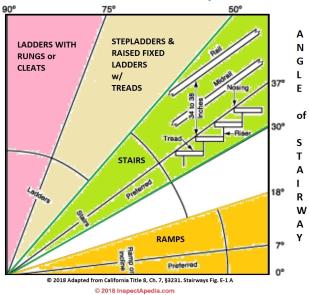 Bottom line: recommended ramp slope:
Bottom line: recommended ramp slope:
The preferred slope for a building access ramp is 1:12 or 1 inch of rise per 12 inches of horizontal run - that's roughly an 8% slope also written as a 4.8 degree angle slope.
While you will see ramps at steeper slopes including the range of 0° to 18° of slope in the illustration shown here and ramps with slopes as steep as 20° in older texts,
to build a ramp that is compliant with the U.S. ADA, the maximum (steepest) ramp slope allowed is either:
Maximum Egress Ramp Slope = 1:12 slope = 8.33% slope = a 4.76° degree slope
Other Ramps Maximum Slope = 1:8 slope = 1.5:12 slope = 12.5% slope = 7.13° slope
Definition of a ramp
In the U.S. per the US ADA (Americans with Disabilities Act), a ramp is a sloping route constructed with a slope greater than 1:20 (one inch of vertical rise for every 20 inches of horizontal length, or run) and must conform to the standard ADA specifications for ramps.
Ramps must [also] be a minimum of 36 inches wide [and require guardrails and graspable handrails - Ed.]
This article series on access ramp design & construction explains and illustrates the requirements for safe, usable interior and exterior access ramps in buildings.
[Click to enlarge any image]
Readers should note that the design specifications for permitted slope and other specifications for ramps that are not used for building entry or exit, such as curb cuts, are different from those used at building entrances.
For example a steeper slope may be permitted on non-access ramps.
For complete details about building access ramp construction: slope, width, railings, non-slip surfaces, steps, landings at ramps, etc. See the standards, code, and ADAReferences or Citations at the end of this document.
The combination of a sloped surface with conditions that can make that walking surface slippery, especially at outdoor building access ramps, forms a falling hazard at both ramp ascent, and ramp descent for nearly everyone.
These hazards are particularly increased if the ramp pitch is too steep. The desirable ramp slope standard, one inch of rise in 12 inches of run (about 8.3 percent slope), has been adopted by most building codes regardless of whether or not the access ramp is specifically for people with disabilities.
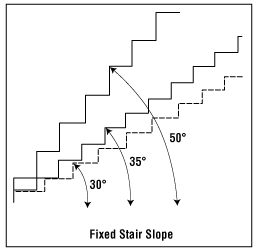 Our illustrations above and below describe the recommended slope range for building access ramps, fixed stairs, and other structures. It will come as no surprise that the effective slope of a fixed stairway is considerably steeper than that allowed for access ramps.
Our illustrations above and below describe the recommended slope range for building access ramps, fixed stairs, and other structures. It will come as no surprise that the effective slope of a fixed stairway is considerably steeper than that allowed for access ramps.
Technical Details of Maximum Ramp Slope
If a building access ramp (also called an egress ramp) is located within an accessible route of travel and is used as a means of egress (exiting from a building), the ramp slope should be 1:12 (4.8 degrees, 8.3 percent) or less in the direction of travel.
This standard is reflected in at least four building standards: UBC 1003.3.4.3, BOCA 1016.3, ADA 4.8.2, IBC 1010.2, and is elaborated in an excellent book that we recommend on stairs and ramps, Slips, Trips, Missteps and Their Consequences, by Bakken et als, found inReferences or Citations at the end of this article.
If the ramp is NOT located within an accessible route of egress (say a ramp giving access between the street and an elevated sidewalk), the slope of the ramp may be a little steeper (1:8 rather than 1:12, or 7.1 degrees, or 12.5 percent) in the direction of travel.
Incidentally, depending on terrain, a ramp may slope upwards towards a building entry/exit door, or it may slope downwards towards the entry door. In either case, the ramp slope rules and standards are the same and the trip/fall hazards are essentially the same.
How to measure the slope of an access ramp
- Project a horizontal line
(use a string, level, and stake if it helps) outwards from the uppermost end of the ramp - say the building entry platform - and the end of the ramp. Keep this line dead level. - Measure the Ramp's Rise:
Measure the height (the vertical distance) from the horizontal line to the ground surface at the end of the ramp or its landing platform. This is the total rise of the ramp. - Measure the Ramp's Run:
Measure the ramp's total horizontal distance from one end of the ramp to the other - say from the point at which the ramp reaches a level building entry platform or entry door to the opposite end of the ramp. - State the Resulting Ramp Slope:
Simply write the total rise divided by the total run to express the slope as a percent (1 inch of rise / 12 inches of run = 8.3% slope), or write the slope as a ratio such as 1:12, also expressed as "one in twelve".
Ramp Slope Example 1: a ramp with a slope of 1:12
if your ramp is twelve feet long (144 inches) and the rise is twelve inches (12 inches) then the slope of the ramp is 12:144, or simplifying, dividing both sides of the equation by 12, the slope can be written as 1:12 - which meets the desired ADA standard.
Ramp Slope Example 2: a ramp with a slope of 4:12
If the ramp is twelve feet long (144 inches) and the total rise is four feet (48 inches) then the slope of the ramp is 48:144, or simplifying by dividing both sides of the equation by 12, the slope of this ramp is written as 4:12 (and the ramp is too steep, likely to result in a fall).
Throughout this article series and in other documents you may see slope expressed as unit rise over unit run, such as 4:12 (4 inches of vertical rise in 12 inches of horizontal run), or you may see the same slope expressed as a percent (unit rise divided by unit run), or slope expressed in angular degrees.
A 4:12 slope ramp = a 33% slope = 18.26 degree slope.
Access Ramp Maximum Run Length
Question: what is the maximum ADA-compliant access ramp length
How long can a ramp run before you need a flat landing area ?
Illustrations [above and below] on which we indicate a 30 ft. or 40 ft. (depending on slope) maximum-recommended access ramp length for a single run before reaching a landing or platform, adapted from the United States Access Board,
retrieved 2019/03/01 original source: https://www.access-board.gov/guidelines-and-standards/buildings-and-sites/about-the-ada-standards/guide-to-the-ada-standards/chapter-4-ramps-and-curb-ramps and from https://www.ada.gov/reg3a/fig16.htm
[Click to enlarge any image]
Reply: Maximum horizontal run for ADA compliant ramps: 30 or 40 ft. depending on slope:
ADA Guidelines for Wheelchair Ramps allow a Maximum run of 30 feet of wheelchair ramp before a rest or turn platform [for ramps with a slope of 1:12 to < 1:16
and
ADA Guidelines for a single ramp run with a slope of 1:16 to < 1:20 allow a maximum run of 40 feet before a rest or turn platform.
Below are some additional ADA ramp length details
Figure 16. Components of a Single Ramp Run and Sample Ramp Dimensions.
Components include a level landing at the top of the ramp, the surface of the ramp and a level landing at the bottom of the ramp.
The rise of the ramp is the vertical dimension and the horizontal projection or run of the ramp is the horizontal dimension.
If the slope of a ramp is between 1:12 and 1:16, the maximum rise shall be 30 inches (760 mm) and the maximum horizontal run shall be 30 feet (9 m).
If the slope of the ramp is between 1:16 and 1:20, the maximum rise shall be 30 inches (760 mm) and the maximum horizontal run shall be 40 feet (12 m).
A4.8.2 Slope and Rise. Ramp slopes between 1:16 and 1:20 are preferred. The ability to manage an incline is related to both its slope and its length. Wheelchair users with disabilities affecting their arms or with low stamina have serious difficulty using inclines.
Most ambulatory people and most people who use wheelchairs can manage a slope of 1:16. Many people cannot manage a slope of 1:12 for 30 ft (9 m).
4.8.4* Landings. Ramps shall have level landings at bottom and top of each ramp and each ramp run. Landings shall have the following features:
(1) The landing shall be at least as wide as the ramp run leading to it.
(2) The landing length shall be a minimum of 60 in (1525 mm) clear.
(3) If ramps change direction at landings, the minimum landing size shall be 60 in by 60 in (1525 mm by 1525 mm).
(4) If a doorway is located at a landing, then the area in front of the doorway shall comply with 4.13.6.
Access Ramp Landing slope
Separately from the slope of the access ramp walkway itself, in some situations a landing or platform may be required along a rampway, depending on the ramp length and the requirement for turning space.
Also see RAMP LANDING CODES.
Landings shall have a slope not steeper than one unit vertical in 50 units horizontal (2-percent slope) in any direction. Changes in level are not permitted. - Florida Building Code 1010.6.1 Landings.
...
Reader Comments, Questions & Answers About The Article Above
Below you will find questions and answers previously posted on this page at its page bottom reader comment box.
Reader Q&A - also see RECOMMENDED ARTICLES & FAQs
On 2020-08-20 by bluerain - building code inspector ha
The escalator landing is 5" higher than the floor. To reduce the tripping hazard it was recommended to have a ramp. Given the space available a slope of 1:8 is not possible. Will a 2-feet ramp 5:24 slope acceptable by code? Not an ADA and not an emergency egress but serves the hotel guest in gatherings. Current code use is IBC2009
I am putting a 2-feet ramp on an escalator landing that is 5-inches higher than floor. The short ramp slope is 5:24 (20.83%). Without the ramp it is acceptable by code. If I place a 2-feet short ramp will I violate the IBC code?
On 2020-08-22 - by (mod) - rdamp at an escalator landing vs trip hazards
Blue
In the case you describe the local building inspector is your final authority. Any other opinion is merely that.
On 2020-07-03 by Roma Rochwani - do I need to provide access ramps at a public exhibition hall?
My project is EXHIBITION FACILITY CENTER where I have provided 2 halls of 3,000 Sq. M. each and also the same on first floor.
As the height of the hall is 8 M. should I provide stairs or ramps? and how? What would be the calculations criteria of both. Please let me knwe ASAP. Thank You.
On 2020-07-03 - by (mod) - does an exhibition hall require access aramps?
Roma
The ADA and equivalent laws in other countries than the U.S. expect you to make a public exhibition hall readily accessible to people in wheelchairs, not just to people who can climb stairs. That means providing properly-designed access ramps.
The article on this page describes access ramp slope requirements. You are welcome to review all of these articles found also in the ARTICLE INDEX
RAMPS, ACCESS - home
RAMP BUILDING CODES
RAMP LANDING CODES
RAMP RAILING CODES
RAMP SLOPE or PITCH
RAMP SLIP TRIP FALL HAZARDS
RAMP SLIP TRIP FALL REDUCTION
and I'll welcome any follow-up questions that arise
Have I missed something?
Ramps may have a maximum slope of 1:12. A 1 in 12 slope = an 8.33% slope = a 4.76 degree slope.
On 2020-04-30 by Luke
The "bottom line" section above says "the preferred slope for a building access ramp is between 7 and 15 degrees, and permitted slopes range between 0 and 20 degrees." However, I'm having difficulty finding any reference for 15 degrees or 20 degrees.
I've only been looking in the IBC so far so perhaps that's the issue, but if you have any other reference that could point me to up to 20 degrees being acceptable, I'd very much appreciate it! Thank you!
On 2020-05-01 - by (mod) - preferred ramp slope in degrees versus percent
Luke
You are dead right, I had typos in the original article - I'm correcting my own mis-speaking between slope expressed as rise:run vs degrees vs %
Thank you so much for taking time to question my error.
the U.S. per the US ADA (Americans with Disabilities Act), a ramp is a sloping route constructed with a slope greater than 1:20 (one inch of vertical rise for every 20 inches of horizontal length, or run) and must conform to the standard ADA specifications for ramps.
On 2020-05-01 by Luke
Sir, thank you for all the references and examples. I assure you that I did make the effort to use the great references section you provided and looked through the IRC and the IBC prior to asking.
I've found very similar to what you provided from the 2018 IRC reflected in the 2018 IBC, sections 1012.2 and 1029.14.1. I think you and I are in agreement in our reading of the various applicable codes but not in our interpretation of the text above on this page.
I believe the crux of the disparity is the units of measurement. My confusion isn't around the numerical value of 20, it's that the text above says twenty DEGREES and the picture above also indicates a maximum of twenty DEGREES, while of the references I've been able to find and of what you've provided in your previous replies, when slope or percentage is converted to degrees, the maximum allowable slope is 7.13 DEGREES; far under the twenty indicated above.
I don't disagree that references are made to a 1 (vertical) : 20 (horizontal) slope ratio, however, as you've well indicated with the provided conversions, both slope RATIO and slope PERCENTAGE are simply not the same as DEGREES. I'm certainly open to the idea that my understanding of this is flawed so I very much thank you for your time and your patience with these questions.
On 2020-05-01 by (mod) - to see article corrections or updates you may need to clear your browser cache
Thank you Luke. I thought this was corrected
I will review again to see if there are still other occurrences where degrees are mixed up with rise or run numbersBe sure to clear your browser cache before refreshing the page so that you were seeing the latest version of this article.
On 2020-05-05 by Luke
Thank you for the reminder on the browser! I think that's exactly what my last disconnect was prior to the previous comment I had posted. Sorry for having repeated myself after you had already sorted things out. Thank you again for your patience and assistance!
On 2019-04-10 by Steve Leist - specifications for delivery ramps
What if the ramp is only for deliveries? ie… FedEx or UPS. Do the same standards apply at a business in Ohio? Currently all deliveries come thru our front door because we only have stairs at our loading dock. I am designing a raised patio to replace the current stairs and thought about adding a ramp. Thank you for your help.
On 2019-04-10 - by (mod) - A ramp that receives only deliveries still needs to be safe.
Steve
Yep. A ramp that receives only deliveries still needs to be safe.
In general the place where we see steps and rails not being required to meet common safety standards is where they are giving access to special areas such as a confined attic space housing a heat pump or A/C unit - entered only rarely and then by just a service technician.A ramp at a business is going to see more traffic than that, not to mention the increased risk of a fall when the FedEx or USP drivers RUN up and down the ramp (in my experience they never walk) or when she is pushing a hand-truck piled so high with boxes that she can't see the edge of the walkway.
OPINION: I'd make it as safe and strong as possible. And as required.
You can read Ohio's access ramp codes under the OH accessibilty law at https://www.com.ohio.gov/documents/dico_August292014BuildingontheCodeAccessibility.pdf
though I agree "accessabilty" for people of limited mobility isn't the same population as delivery truck operators.
On 2017-10-06 by Wendy Eplen - can you build a ramp for me?
I live in Wharton, Texas and amdisabled getting in and out of my home is a nighmare can you please help me? I would appreciate any assistance you can provide.
Thank You,
Wendy Eplen
Wendy Eplen
416 Croom Drive
Wharton, Texas 77488
phone: (979) 282-1846
email: wmeplen.h@gmail.com
On 2017-10-08 - by (mod) - what if I need a ramp at my home: can you build it for me?
Wendy,
I can help with researching and answering specific questions, but to be clear, We do not sell anything.
InspectAPedia provides building and environmental diagnostic and repair information.
In order to absolutely assure our readers that we write and report without bias we do not sell any products nor do we have any business or financial relationships that could create such conflicts of interest.
InspectAPedia is an independent publisher of building, environmental, and forensic inspection, diagnosis, and repair information for the public - we have no business nor financial connection with any manufacturer or service provider discussed at our website. We very much welcome critique, questions, or content suggestions for our web articles.However we will be glad to help you if specific ramp construction or code issues arise when you find and are working with a local contractor or carpenter.
Any deck builder in your area ought to be competent to build an access ramp, and in some communities there may be financial aid available to you as well.
Contact for help around Wharton Texas
Intellectual/Developmental Disability Contacts
Texana Center 4910 Airport Ave. Rosenberg, TX 77471
http://www.texanacenter.com/
Main Intake Phone Number: 281-239-1363
Main Phone Number: 281-239-1300 or 1-866-4TEXANA
 Question: what is the correct number for permitted ramp slope in degrees?
Question: what is the correct number for permitted ramp slope in degrees?
2020/04/20 Luke said:
The "bottom line" section above says "the preferred slope for a building access ramp is between 7 and 18 degrees, and permitted slopes range between 0 and 20 degrees." However, I'm having difficulty finding any reference for 15 degrees or 20 degrees.
I've only been looking in the IBC so far so perhaps that's the issue, but if you have any other reference that could point me to up to 20 degrees being acceptable, I'd very much appreciate it! Thank you!
Moderator reply:
Luke
Thank you for pointing out an error in our original text. I've reviewed and corrected and clarified the question of allowable ramp slope on this page.
The "20" in the text above is correctly written as a slope of 1 in 20, also written as 1:20 or 1 inch of vertical rise in 20 inches of horizontal run.
I'm editing the text to be sure it's clear.
We are NOT talking about a 20 degree angle of slope.
The ADA, code and recommended slope angle is typically 1:12 or 1 inch of rise in 12 inches of horizontal run - that's
Maximum Egress Ramp Slope = 1:12 slope = 8.33% slope = a 4.76° degree slope
Other Ramps Maximum Slope = 1:8 slope = 1.5:12 slope = 12.5% slope = 7.13° slope
Typically in sketches and plans like the drawing we show above where common ramp slopes are in the orange area, ramp slopes range between 0° and 18° with a preferred slope of about 7° or 1.5:12 or by the 2018 IRC Ramp Code, a more-gentle slope of about 5° or 1:12.
2018 IRC Ramp Code - Maximum Slope
R311.8 Ramps.
R311.8.1 Maximum [Ramp] slope.
Ramps serving the egress door required by Section R311.2 shall have a slope of not more than 1 unit vertical in 12 units horizontal (8.3-percent slope).
All other ramps shall have a maximum slope of 1 unit vertical in 8 units horizontal (12.5 percent).
Exception: Where it is technically infeasible to comply because of site constraints, ramps shall have a slope of not more than 1 unit vertical in 8 units horizontal (12.5 percent).
- Source: IRC as adopted by the City of Los Angeles, cited as Los Angeles Residential Code, 3 Building Planning, R311 Means of Egress , R311.8 Ramps , R311.8.1 Maximum slope (2020/05/01)
Notes about How to Calculate Slope or Rise:Run Angle or Percent
Slope in Rise / Run x 100 = Slope in Percent
Slope in Degrees = Tan-1 (Slope Percent/100)
A 1:12 slope (rise over run) has a percentage slope of 8.33 % that, converted to degrees is: 4.76° of slope
A 1.5:12 slope (rise over run) has a percentage slope of 12.5 % that, converted to degrees is: 7.13° of slope
Synonyms for slope include pitch, angle, rise, incline, or grade.
To see details of converting percent slope to degrees of slope
see CONVERT ROOF SLOPE or ANGLE in DEGREES to RISE - that pertains to ramps and stairs as well
Also
see FROGS HEAD SLOPE MEASUREMENT where we demonstrate the use of both TAN and (TAN-1) .
...
Continue reading at RAMP SLIP TRIP FALL HAZARDS or select a topic from the closely-related articles below, or see the complete ARTICLE INDEX.
Or see these
Recommended Articles
- ACCESSIBLE DESIGN
- ADA STAIR & RAIL SPECIFICATIONS
- BATHROOM DESIGN, ACCESSIBLE
- CUSTOM TOILETS
- DISABLED or ELDERLY-USE TOILETS
- ELDERLY & VETERANS HOME SAFETY
- KITCHEN DESIGN, ACCESSIBLE
- RAMPS, ACCESS - home
- RAMP CODES & STANDARDS
- RAMP LANDING CODES
- RAMP RAILING CODES
- RAMP SLOPE or PITCH
- RAMP SLIP TRIP FALL HAZARDS
- RAMP SLIP TRIP FALL REDUCTION
- ROOF SLOPE CALCULATIONS Definition & Uses of Tangent & Tan-1 when Working With a Right Triangle (building roofs, stairs, walks, or whatever)
- STAIR ANGLE & SLOPE
- STAIR CODES
- STAIR DESIGN for SENIORS
- STAIRWAY CHAIR LIFTS
- TANGENT & SLOPE CALCULATIONS
Suggested citation for this web page
RAMP SLOPE or PITCH at InspectApedia.com - online encyclopedia of building & environmental inspection, testing, diagnosis, repair, & problem prevention advice.
Or see this
INDEX to RELATED ARTICLES: ARTICLE INDEX to STAIRS RAILINGS LANDINGS RAMPS
Or use the SEARCH BOX found below to Ask a Question or Search InspectApedia
Ask a Question or Search InspectApedia
Try the search box just below, or if you prefer, post a question or comment in the Comments box below and we will respond promptly.
Search the InspectApedia website
Note: appearance of your Comment below may be delayed: if your comment contains an image, photograph, web link, or text that looks to the software as if it might be a web link, your posting will appear after it has been approved by a moderator. Apologies for the delay.
Only one image can be added per comment but you can post as many comments, and therefore images, as you like.
You will not receive a notification when a response to your question has been posted.
Please bookmark this page to make it easy for you to check back for our response.
IF above you see "Comment Form is loading comments..." then COMMENT BOX - countable.ca / bawkbox.com IS NOT WORKING.
In any case you are welcome to send an email directly to us at InspectApedia.com at editor@inspectApedia.com
We'll reply to you directly. Please help us help you by noting, in your email, the URL of the InspectApedia page where you wanted to comment.
Citations & References
In addition to any citations in the article above, a full list is available on request.
- Access Ramp building codes:
- UBC 1003.3.4.3
- BOCA 1016.3
- ADA 4.8.2
- IBC 1010.2
- ADA (Americans with Disabilities Act), Public Law 101-336. 7/26/90 is very often cited by other sources for good design of stairs and ramps etc. even where disabled individuals are not the design target.
- ANSI A117.4 Accessible and Usable buildings and Facilities (earlier version was incorporated into the ADA)
- ASTM F 1637, Standard Practice for Safe Walking Surfaces, (Similar to the above standards)
- In addition to citations & references found in this article, see the research citations given at the end of the related articles found at our suggested
CONTINUE READING or RECOMMENDED ARTICLES.
- Carson, Dunlop & Associates Ltd., 120 Carlton Street Suite 407, Toronto ON M5A 4K2. Tel: (416) 964-9415 1-800-268-7070 Email: info@carsondunlop.com. Alan Carson is a past president of ASHI, the American Society of Home Inspectors.
Thanks to Alan Carson and Bob Dunlop, for permission for InspectAPedia to use text excerpts from The HOME REFERENCE BOOK - the Encyclopedia of Homes and to use illustrations from The ILLUSTRATED HOME .
Carson Dunlop Associates provides extensive home inspection education and report writing material. In gratitude we provide links to tsome Carson Dunlop Associates products and services.


